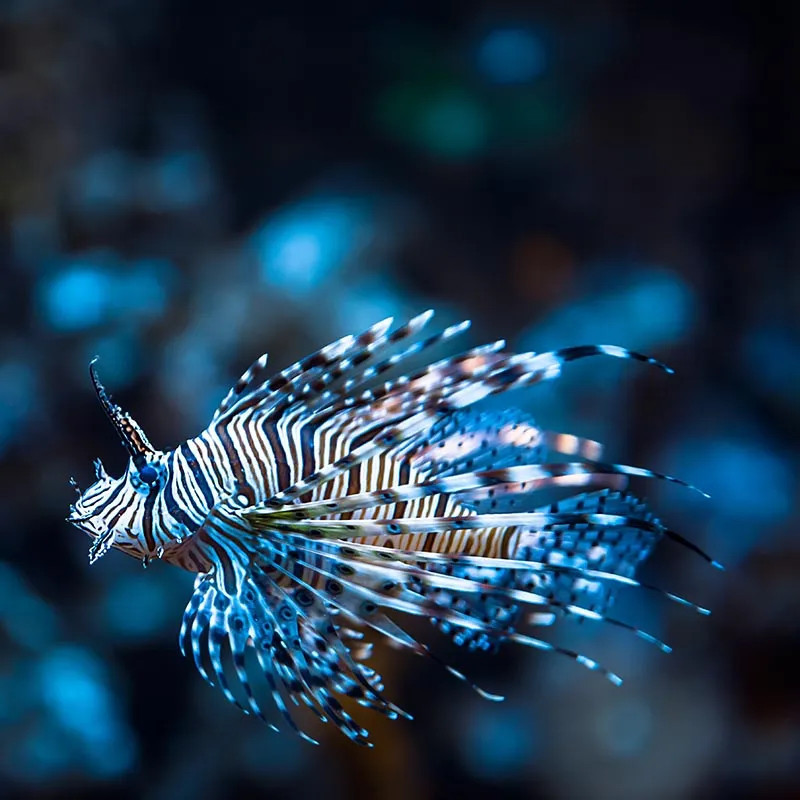Introduction
- Species: Red Volitan Lionfish
- Common Names: Red Lionfish, Volitans Lionfish, Devil Firefish
- Natural Habitat: Native to the Indo-Pacific region, this species inhabits coral reefs, lagoons, and rocky crevices. It has also become invasive in parts of the Atlantic and Caribbean.
Physical Characteristics
- Appearance: The Red Volitan Lionfish is renowned for its striking appearance, featuring large, fan-like pectoral fins and elongated, venomous dorsal spines. Its body showcases bold vertical stripes in reddish-brown, white, and black.
- Size: Reaches up to 15 inches (38 cm) in length, though typically stays around 12 inches in home aquariums.
- Lifespan: Lives 10-15 years in captivity with proper care.
Habitat Requirements
- Tank Size: Minimum of 120 gallons, with larger tanks recommended for adult lionfish.
- Water Conditions:
- Temperature: 72-80°F (22-27°C)
- pH: 8.1-8.4
- Salinity: Specific gravity of 1.020-1.025
- Aquascaping: Provide ample hiding spots using live rock for caves and overhangs, along with open swimming areas for nocturnal activity.
Diet
- Primary Diet: Carnivorous; in the wild, it preys on smaller fish and invertebrates.
- Supplemental Feeding: In captivity, feed a varied diet of meaty foods such as shrimp, squid, and fish. Avoid regular use of feeder fish to prevent health issues.
- Feeding Frequency: Feed two to three times weekly. Ensure adequate time for the lionfish to consume its food, as it can be a slow feeder.
Compatibility
- Temperament: Though generally peaceful toward larger tank mates, it is an ambush predator and will consume smaller fish and invertebrates.
- Suitable Tank Mates: Ideal companions include large, non-aggressive species such as groupers, tangs, and angelfish.
- Incompatibilities: Avoid housing with small fish or crustaceans, as they will likely become prey.
Care Level
- Difficulty: Moderate; requires a spacious tank, stable water parameters, and careful feeding practices due to its venomous spines.
- Health Monitoring: Watch for signs of stress or illness and ensure proper feeding. Avoid direct handling to prevent painful stings from venomous spines.
Breeding
- Breeding in Captivity: Rarely achieved in home aquariums. Successful breeding requires large, well-established tanks.
- Spawning: Males perform courtship displays, and females release egg clusters that are fertilized externally.
Economic Considerations
- Market Demand: Highly sought after in the aquarium trade for its unique and striking appearance.
- Pricing: Moderately to highly priced depending on size, availability, and location.
Sustainability and Conservation
- Wild Population: Stable in its native range, but invasive in parts of the Atlantic and Caribbean, where it lacks natural predators and disrupts local ecosystems.
- Aquaculture Efforts: Efforts to control invasive populations are ongoing, but most lionfish in the trade are wild-caught.
Conclusion
The Red Volitan Lionfish is a visually stunning centerpiece for experienced marine aquarists. Its bold coloration, flowing spines, and unique behavior make it a standout addition to large aquariums. However, its size, predatory nature, and venomous spines demand careful care and planning. With the right environment and tank mates, this species can thrive and provide an impressive display for many years.
